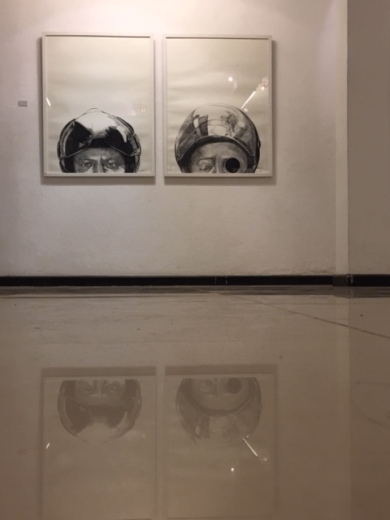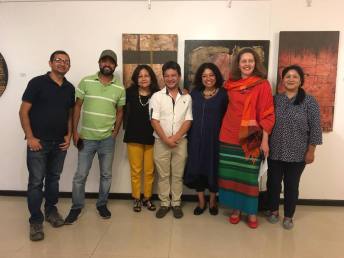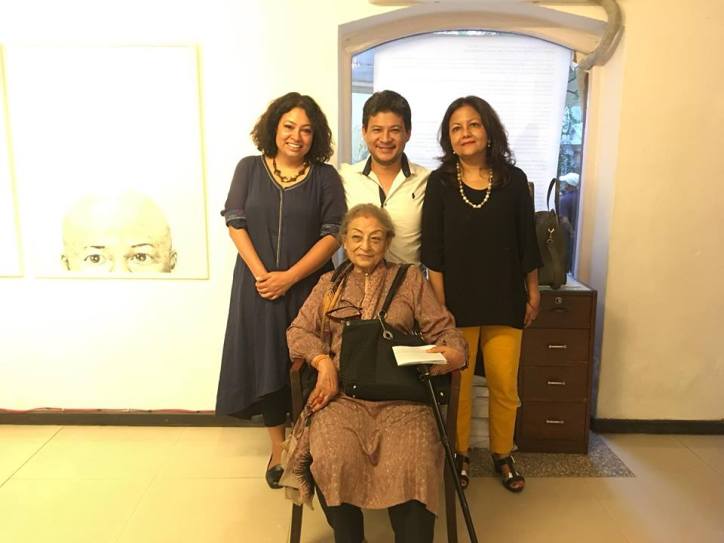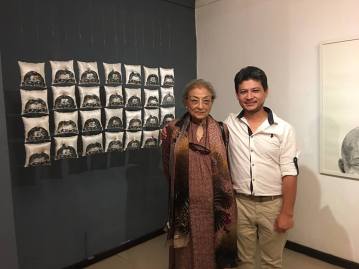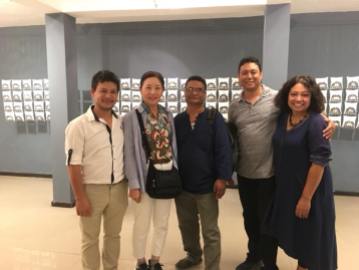INTRODUCTION BY SANGEETA THAPA
DIRECTOR – SIDDHARTHA ART GALLERY
This exhibition marks the seventh series of works produced by recipients of the Australian Himalayan Art Award, and follows on from the first successful inaugural exhibition launched in April 2011. Endowing the arts continues to be a new concept in Nepal. The Australian Himalayan Art Award, endows two promising Nepali artists with a special fund that enables them to work towards an exhibition after an eight month period, at the Siddhartha Art Gallery. Recommending two names for the award is always a challenge as the pool of talented young artists continues to grow. The two established artists Bidhata KC and Manish Lal Shrestha were selected by the Australian Himalayan Foundation to provide support for the spectacular commissioned works made by these two artists for the Kathmandu Triennale. Today their works have progressed and taken on a new dimension due to the Australian Himalayan Foundation Art Award.
In his series of work Sirani | the Headrest, Manish pays poignant tribute to his late Mother, also a textile artist, with his ten self-portraits or ten avatars in pen and ink. The artist visage reflects a myriad emotions: grief, bewilderment. His installation is evocative of the lap of his mother, upon which he laid. The installation consists of 108 auspicious headrests with the artist portrait, silk screened onto silk satin. Manish sews on a color button as a symbolic color intervention punctuating the cerebral area, where random memories of love are aroused. For an artist so deeply entrenched in the arts, his work are cathartic process in itself as he interrogates how society is culturally bound to observe the harsh rites of mourning. We see how Manish, the artist and son, internalizes his grief and creatively transforms the rites of mourning as journey of love, loss and spirituality.
In her present series Shifting Values| Expectation Versus Reality Bidhata continues with her exploration of local culture; the awe inspiring sculptural form of the Machendranath chariot with its myths and legends and the equally magnificent geographic landscape of remote Mustang, its unique architecture and walled city, its culture and traditions, all of which are sadly undergoing transformation with road connectivity. Bidhatha’s works pose important questions – will Mustang be as alluring if it architecture is replaced by concrete structures, its unique culture replaced by modern alternatives. In our quest to preserve our heritage are we then out of sync with a remote Kingdom and her people who yearn for “development”? The quest for modernity has ravaged Kathmandu and destroyed the traditional architecture of the Valley – will this be the fate of Mustang too? The artist highlights how modernity has seeped into cultural spaces and practices in Mustang and Kathmandu. Her works pay homage to the beauty of ancient traditions, it also depicts how Kathmandu is evolving as a modern day city where its inhabitants constantly sway from a pendulum between culture and modernity. The Australian Himalayan Foundation endeavor towards promoting contemporary artists in Nepal and giving the Art Awards continuity is truly laudable. We hope that this exhibition will encourage other donors to think about how they can play a role in supporting the arts. Both Bidhata and Manish have worked with great sincerity towards this show – we wish them every success on their artistic journey.
Sirani: the headrest
Life is a cluster of time and thoughts. It is metamorphosis of different emotional stigmas. Throughout my process of art creation, my personal indulgence is directed towards the vibrative metaphor of sound, situations and fractions of time. Art and life are interrelated and bound by correlative entities. Through these interrelated queries, my art moves towards the ideology of spiritualism. The meaning of life changes with time and circumstances.
Sirani: the headrest is a conceptual quest that interrogates social, personal and conservative circumstances. It is an experiment that explores the psychological and emotional realm, where queries about the meaning of life and death are addressed. The series of works have been created with pen and ink drawing with dots. Dots, depict the sound of impermanence, the breath of seconds, the relentless journey of time and the fragmented realm of the thoughts. In Nepal white symbolizes mourning, red is regarded as an auspicious color and is associated with weddings, while black is regarded as inauspicious, or ashuva, and represents bad fortune.
Sirani represents the lap of the mother which is so soft and yet protective. I know that I have been facing some kind of psychological and emotional pressure after my mother passed away. There are so many obligations: it is Ashuva to wear colorful clothes, as it is a sign of mourning, and yet, it is not out of choice but out of obligation.
After the day I cremated my mother, I did not feel like going anywhere, attending any Shuvakarya, or auspicious ceremonies. Though it is obligatory not to attend auspicious programs while mourning, I have stayed away from attending such auspicious functions, out of my own personal feelings borne from the love and respect I feel for my mother who gave birth to my sisters and I, and who brought us up. Throughout this year I did not feel like using color pigments to paint. In the memory of my mother, I stopped using colors to paint for a year. This is a personal and spiritual ritual that I have consciously undertaken to awaken my consciousness while paying tribute to my Mother for giving me life.
Making these works is an emotional and sensitive process and is the metaphor of this series of works. I question why such conservative socio-cultural practices have become a restrictive part of life. The answers I receive are in terms of Dharma (Good Deed) and Paap (Bad Evil). In my simple understanding of life – if one has positive feeling towards their deed it is good, and if one harbors negative feelings towards their deed it is bad. With my recent performance Seto Chappal, (white slippers, worn during mourning)) I instigated a series of silent questions to the audience. The audience was receptive as they have to undergo the same socio-cultural circumstances too and face the same psychological pressures within their life time. Sirani is the realization of the self, and living with the serenity of life. I have depicted myself in number of ways: as a monk, as a stranger to the inner self and in meditation sometimes staring at life. Death is the ultimate truth of life. And yet we are anxious in the face of this truth and live in fear.
Life is all about good and bad, happiness and sadness, pleasant and unpleasant feelings. The series of Sirani: the headrest is the metaphor of comfort, healing norms, protection and a feeling of Contentment.
Manish Lal Shrestha
Multi-Disciplinary Visual Artist
Shifting Values | Expectation versus Reality
A particularly pink coloured umbrella inspired this series. Members of the royal family of Mustang, especially the “Rajas” are shown respect by providing them coverage under an umbrella’s shade. In Tiji Festival that I attended in 2014 in Lo, upper Mustang, the Raja was covered under a normal commercially available pink coloured umbrella. As per tradition, the umbrella used for Kings is considered sacred and is made of cloth and exquisitely decorated. I was surprised by how modernization had colonized traditional practices, all the way to Mustang. This is a trend I see all over Nepal and this exhibition portrays how Nepali society is adapting to modernization.
In this exhibition, I explore how the touch of modernization will slowly replace traditional practices and might even lead to the disappearance of some of these practices. If the walls of Mustang start to get covered in cement, instead of the iconic stone and mud walls, which is the identity of the place, will Mustang still remain the same? This is not just a single incident but other social and cultural components have made me realize how newer practices seep inside traditional practices. I explore more of this through my portrayal of Machhindranath and the gentrification of my own neighbourhood in Satdobato, where traditional houses are replaced with tall cemented and glassed rectangular towers.
Our values, practices and traditions move forward with time and its inevitable, but does moving forward mean not preserving the values upon which the newer ones were based?
Bidhata KC
Visual Artist
PC: Art Nepal, Bidhata KC, Rabin Kaji Shakya




